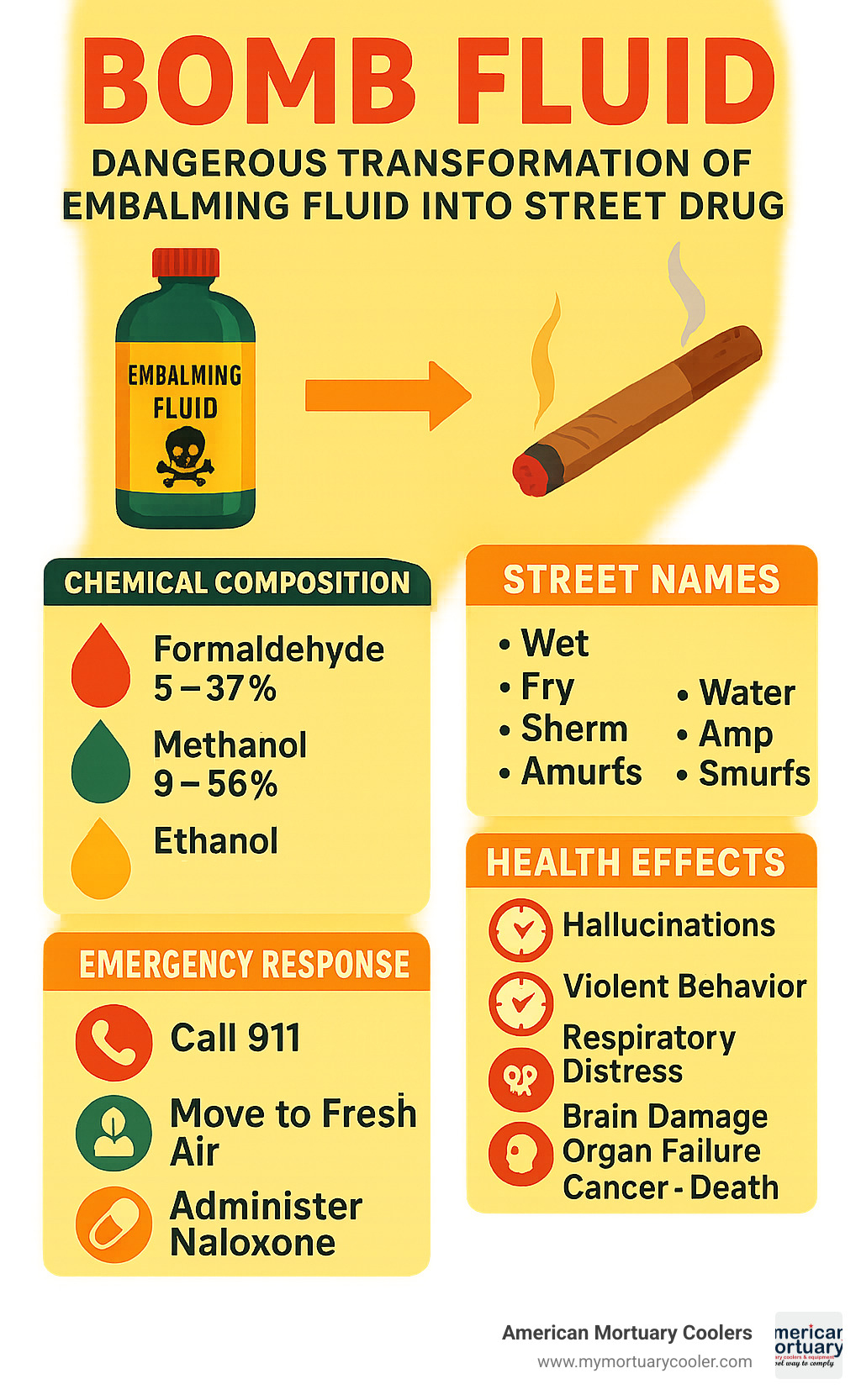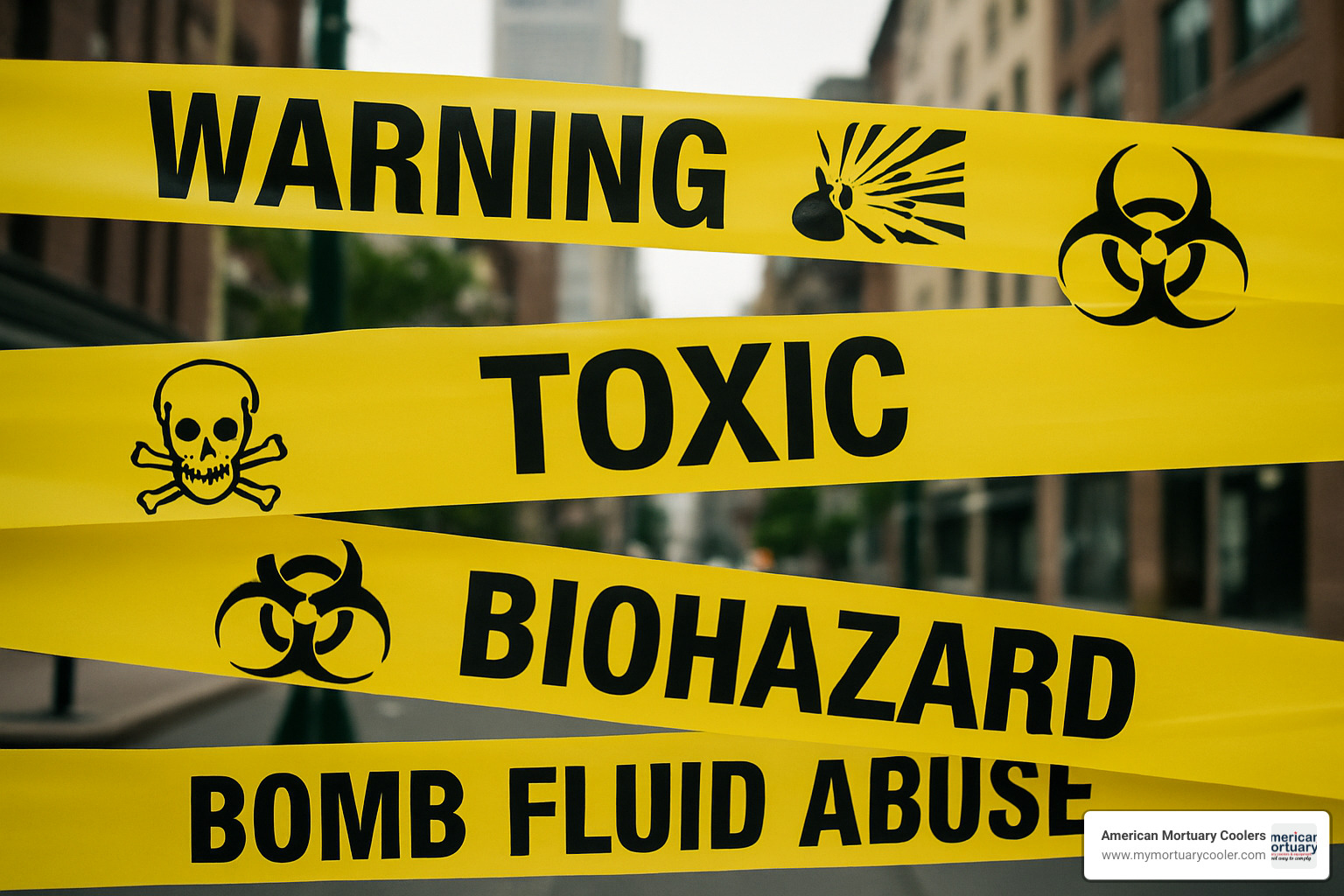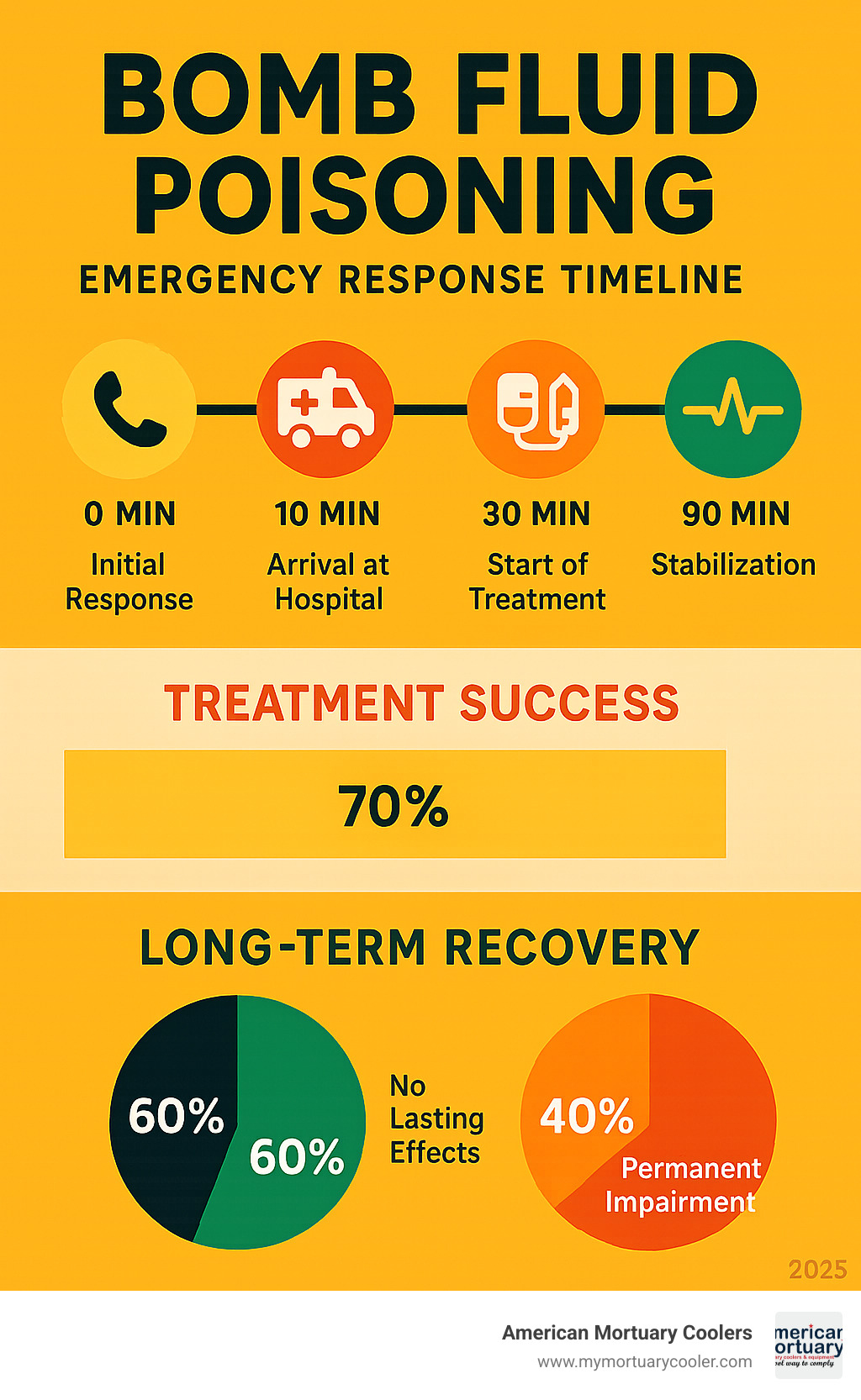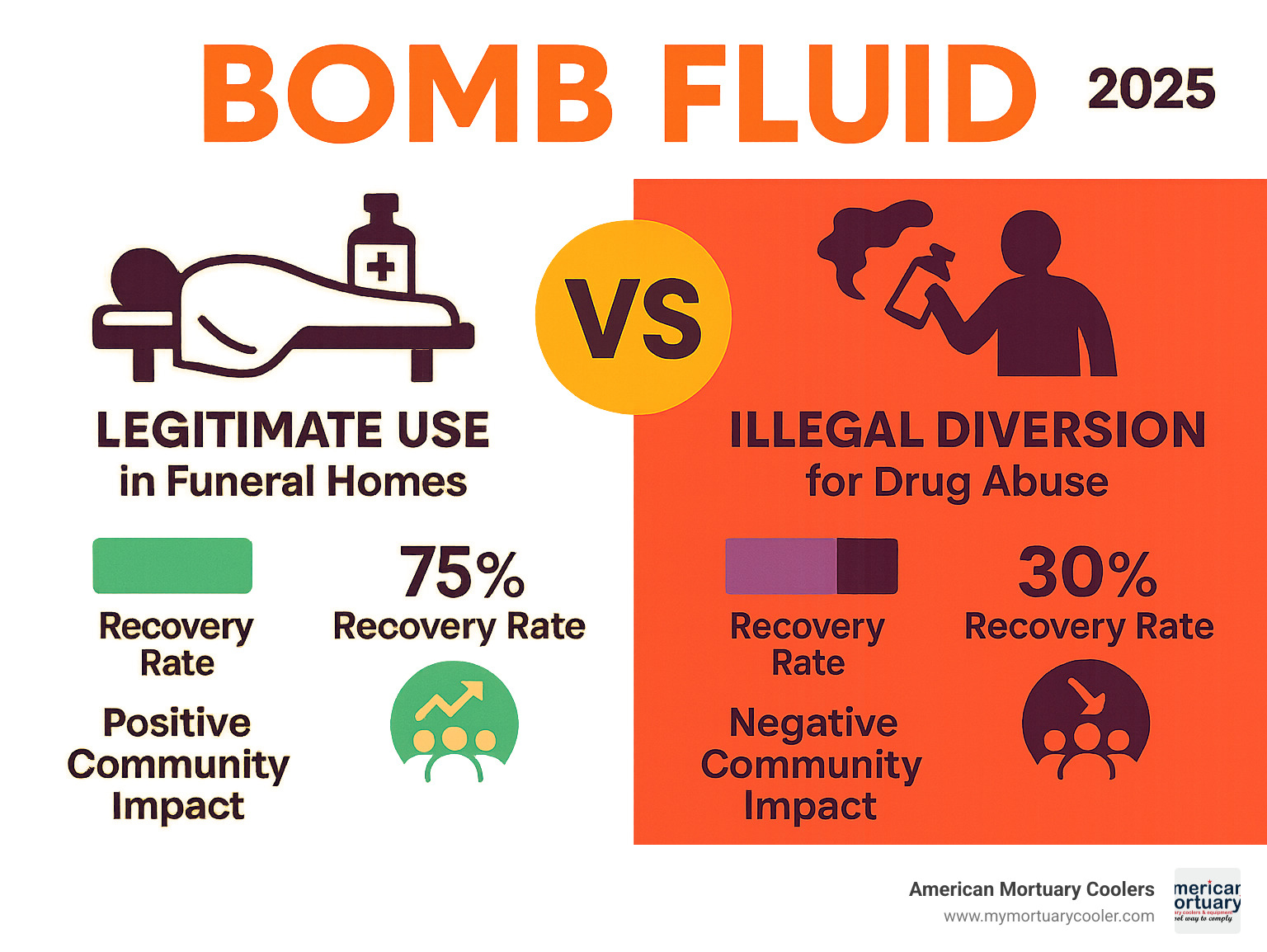
Beginner's Guide to Bomb Fluid: Meaning and Uses Explained
What Is Bomb Fluid and Why You Need to Know About It
Bomb fluid is a dangerous street drug created by dipping cigarettes or marijuana in embalming fluid, which contains toxic chemicals like formaldehyde, methanol, and ethanol. This practice emerged from confusion over PCP slang terms in the 1970s.
Quick Facts About Bomb Fluid:
- What it is: Tobacco or marijuana cigarettes soaked in embalming fluid
- Street names: Wet, fry, sherm, water, amp, smurfs
- Main chemicals: Formaldehyde (5-37%), methanol (9-56%), ethanol
- Effects: Hallucinations, violent behavior, respiratory distress
- Risks: Brain damage, organ failure, cancer, death
- Legal status: Illegal under Controlled Substances Act
The term "bomb fluid" refers to this toxic mixture that creates unpredictable and extremely dangerous highs. Unlike pure PCP, embalming fluid contains preservative chemicals never meant for human consumption.
Research shows that drinking just 1 ounce of formalin (37% formaldehyde solution) can kill an adult. When smoked, these chemicals cause severe respiratory damage and long-term neurological problems.

Bomb fluid helpful reading:
What Is Bomb Fluid? Origins, Street Names & Evolution
The story of bomb fluid starts with a tragic mix-up in the 1970s. Street dealers used "embalming fluid" as code for liquid PCP - they'd dip cigarettes in the drug and sell them. But some people took this slang literally.
When dealers started running out of PCP or looking for cheaper alternatives, they began using actual embalming fluid from funeral homes. What had been street slang became a deadly reality.

How "bomb fluid" Got Its Name
The name "bomb fluid" comes from the explosive, unpredictable reactions users have when they smoke cigarettes soaked in embalming fluid. Unlike the original PCP mixture, this toxic cocktail creates a chemical "bomb" inside the body.
Embalming fluid is designed to preserve dead tissue. When someone smokes it, those same preservative chemicals attack living cells throughout their body.
Common Street Names for Bomb Fluid
Bomb fluid hides behind dozens of street names. The most common term is "wet" - referring to cigarettes that are "wet" with embalming fluid. You'll also hear "fry," "sherm," "water," "amp," and "smurfs."
This constantly changing vocabulary makes it hard for parents, teachers, and healthcare workers to recognize when someone is talking about bomb fluid use.
Chemistry & Manufacturing: What's Really Inside Bomb Fluid
When you look at what's actually in bomb fluid, it becomes clear why this stuff is so dangerous. We're talking about industrial-strength chemicals designed to preserve dead bodies.
Typical embalming fluid contains formaldehyde (5-37%), methanol (9-56%), ethanol, up to 2.7% phenol, and other solvents and preservatives.
Funeral homes across America use roughly 20 million liters of embalming fluid every year. With that much volume, some unfortunately ends up in the wrong hands.
Scientific research on embalming chemicals shows formaldehyde causes cancer, destroys body tissue, damages your brain and lungs, and creates painful sores throughout your throat, nose, and esophagus.
Bomb Fluid vs. PCP: Key Chemical Differences
PCP was developed in the 1950s as an IV anesthetic for medical use. It works by blocking NMDA receptors in your brain, creating predictable (though dangerous) effects.
Bomb fluid is completely different. The formaldehyde acts as a cross-linking agent that literally starts "fixing" your living tissue the same way it preserves dead bodies. The methanol causes your blood to become acidic and attacks your nervous system.
How Bomb Fluid Is Obtained or Made
Bomb fluid reaches the streets through theft from funeral homes, morgues, or medical facilities. Some criminals steal from chemical supply companies or make fraudulent purchases.
Once they get the embalming fluid, the "manufacturing" process is simple - they soak cigarettes or marijuana in the toxic liquid, then let them dry before selling them.
More info about Embalming Fluid covers how these chemicals should actually be used safely.
Health Effects & Risks of Using Bomb Fluid
When someone uses bomb fluid, they're poisoning themselves with industrial chemicals designed to preserve dead tissue. The health consequences are swift, severe, and often permanent.
Immediate effects include hallucinations and delusions, feeling of superhuman strength while losing all sense of pain, violent, unpredictable behavior, numbness and loss of coordination, dangerous spikes in heart rate and blood pressure, and respiratory distress.

Long-term damage includes permanent brain damage, chronic speech difficulties, depression and anxiety disorders, and significant cancer risk from formaldehyde exposure.
Latest research on smoking wet confirms that even using bomb fluid once can cause lasting damage to the brain and respiratory system.
Mixing Bomb Fluid With Other Drugs
Combining bomb fluid with other substances creates potentially fatal reactions. Alcohol and bomb fluid can cause severe metabolic acidosis. Opioid combinations suppress breathing while formaldehyde damages lung tissue. Stimulant combinations create extreme stress on the heart and brain.
Signs, Symptoms & Overdose Response
Physical warning signs include rapid eye movements, profuse sweating, difficulty breathing, slurred speech, and loss of coordination. Behavioral changes include extreme agitation, violence, paranoia, or complete unresponsiveness.
Call 911 immediately - this is always a medical emergency. You can also text TALK to 741741 for crisis counseling support, and contact the 988 Suicide and Crisis Lifeline if the person threatens self-harm.
Stay with the person until help arrives, but prioritize your own safety.
Safety, Law & Community Prevention Around Bomb Fluid
The legal landscape around bomb fluid is complex. While marijuana and PCP have specific classifications, embalming fluid creates a gray area that prosecutors handle through theft and public endangerment charges.
When someone steals embalming fluid from funeral homes, they're typically charged with theft of hazardous materials. The environmental dangers extend beyond the user - formaldehyde can linger in indoor air for days and contaminate water sources.

Community prevention works best when it combines education with practical security measures. Schools with bomb fluid awareness programs report better recognition of warning signs. Funeral homes with upgraded security systems see dramatic reductions in chemical theft.
What to Do in Case of Bomb Fluid Poisoning
Bomb fluid poisoning is a chemical emergency requiring immediate action. Call 911 and specifically mention possible formaldehyde or embalming fluid exposure.
While waiting for help, get the person to fresh air if safe. Remove contaminated clothing, and flush skin or eyes with clean water if there's been direct contact. Never try to make someone vomit.
Hospital treatment typically involves activated charcoal, mechanical ventilation, IV fluids, and medications to control seizures or heart rhythms.
More info about the Embalming Process covers legitimate uses and safety protocols.

Treatment & Recovery Options for Bomb Fluid Addiction
Getting help for bomb fluid addiction requires treating both addiction and chemical poisoning simultaneously. This makes recovery more complicated, but it's possible with proper medical care.
Medical detoxification must happen in a hospital setting. Doctors monitor for formaldehyde-related organ damage, provide respiratory support, conduct neurological assessments, and provide psychiatric evaluation.
Therapeutic recovery focuses on Cognitive Behavioral Therapy (CBT), individual counseling, group therapy, and family therapy. Support programs like SMART Recovery and Narcotics Anonymous provide ongoing peer support.
Harm reduction strategies include safe housing, ongoing medical monitoring, vocational rehabilitation, and mental health treatment for depression, anxiety, and suicidal thoughts.
Recovery often takes longer than other substances because physical damage can be permanent. Some people struggle with memory problems, speech difficulties, or breathing issues for years.
More info about Embalming Equipment Options discusses safe chemical handling.
When to Seek Help for Bomb Fluid Use
Physical dependence shows up through tolerance, severe withdrawal symptoms, inability to function normally, persistent respiratory problems, and memory loss and cognitive impairment.
Behavioral changes include isolation from family and friends, loss of employment or school performance, dangerous or illegal activities to obtain the drug, neglect of personal hygiene, and suicidal thoughts or self-harm behaviors.
Dual diagnosis situations are common, as many users already struggle with depression, anxiety, or trauma. Effective treatment must address both addiction and underlying psychological issues.
Community Resources & Hotlines
For immediate crisis situations, the 988 Suicide and Crisis Lifeline provides 24/7 mental health emergency support. For medical emergencies, 911 gets paramedics trained in toxic chemical exposure. The Crisis Text Line (text TALK to 741741) offers counseling support.
Ongoing recovery resources include Narcotics Anonymous meetings, SMART Recovery, local health departments, and community mental health centers.
Frequently Asked Questions about Bomb Fluid
Is bomb fluid the same thing as PCP?
Bomb fluid and PCP are completely different substances, though the confusion between them has created one of the most dangerous mix-ups in street drug history. The confusion started back in the 1970s when dealers used "embalming fluid" as slang for liquid PCP - they weren't actually using real embalming fluid at that time.
PCP, or phencyclidine, was originally developed as an IV anesthetic in the 1950s for legitimate medical use. It works as an NMDA receptor antagonist in the brain and, while dangerous, has somewhat predictable effects. It's a Schedule II controlled substance that was discontinued for medical use due to serious side effects.
Bomb fluid, on the other hand, contains actual embalming chemicals like formaldehyde, methanol, and ethanol. These are industrial preservatives designed to prevent decomposition in deceased bodies - they were never meant for any living person to consume. When someone smokes or ingests these chemicals, they're essentially poisoning themselves with toxic preservatives.
The tragic irony is that what started as a street name eventually became a literal practice, with devastating consequences for users who thought they were getting something similar to PCP but instead got industrial toxins.
Can bomb fluid be detected on a drug test?
Standard drug tests won't catch all the components of bomb fluid, which creates challenges for employers, parents, and healthcare providers trying to identify use. Most routine drug screens look for common substances like marijuana, cocaine, PCP, and opioids - but they're not designed to detect formaldehyde or other embalming chemicals.
However, there are ways to identify bomb fluid use. Since most bomb fluid involves marijuana or tobacco cigarettes soaked in embalming fluid, the marijuana component will show up on standard tests. The bigger concern is that by the time someone is getting drug tested, they may have already suffered serious health consequences from the toxic chemicals.
Specialized toxicology testing can identify formaldehyde exposure and methanol poisoning, but these tests are typically only performed in emergency rooms or forensic situations. Formaldehyde breaks down quickly in the body, but its metabolic byproducts can be detected in urine for several days after exposure.
The unpredictable nature of bomb fluid composition makes testing even more complicated - users often don't know exactly what chemicals they've been exposed to, making targeted testing difficult.
How long do the effects of bomb fluid last?
The effects of bomb fluid are as unpredictable as they are dangerous, lasting anywhere from several hours to several days depending on the chemical concentration and amount used. Unlike prescription drugs with known half-lives, embalming fluid creates chaotic effects because it's essentially poisoning the body with industrial preservatives.
The immediate effects hit within 2-5 minutes of smoking and include hallucinations, breathing difficulties, and increased heart rate. These aren't the controlled effects of a manufactured drug - they're the body's emergency response to toxic chemical exposure.
Short-term effects can persist for 2-24 hours and often include continued hallucinations, violent behavior, speech problems, and loss of coordination. Some users fall into comas or become completely unresponsive during this phase.
The most concerning aspect is the long-term effects, which can last days, months, or even become permanent. Cognitive problems, memory loss, depression, and respiratory complications are common. The formaldehyde in embalming fluid is a known carcinogen that can cause lasting organ damage.
At American Mortuary Coolers, we work with funeral professionals who understand the legitimate uses of these chemicals. The idea that someone would intentionally expose themselves to substances designed to preserve dead tissue is both tragic and completely preventable with proper education about the real dangers involved.
Conclusion
The story of bomb fluid serves as a stark reminder of how dangerous misunderstandings can spiral into public health crises. What began as street slang for PCP evolved into the actual use of industrial embalming chemicals designed to preserve the dead.
At American Mortuary Coolers, we work with funeral homes across Tennessee, Georgia, Illinois, South Carolina, Texas, California, New York, and Pennsylvania. We've witnessed the dignity that proper embalming brings to grieving families, while also seeing how these same chemicals are tragically misused.
The health consequences - brain damage, organ failure, and psychological trauma - represent real people in communities we serve. Every case of bomb fluid poisoning is a life forever changed, a family forever impacted.
Recovery is possible, but requires specialized medical care addressing both addiction and toxic chemical exposure. The 988 Suicide and Crisis Lifeline, local treatment centers, and community health resources provide hope for those ready to seek help.
Education remains our most powerful tool against bomb fluid abuse. When communities understand the real dangers, they're better equipped to protect their loved ones and recognize warning signs.
If someone you know is struggling with bomb fluid use, please don't wait. The toxic nature of these chemicals means every use could be the last. Help is available, recovery is possible, and no one has to face this alone.
For more information about legitimate mortuary practices, visit our comprehensive mortuary solutions where we continue working to honor both the living and the dead with integrity.




